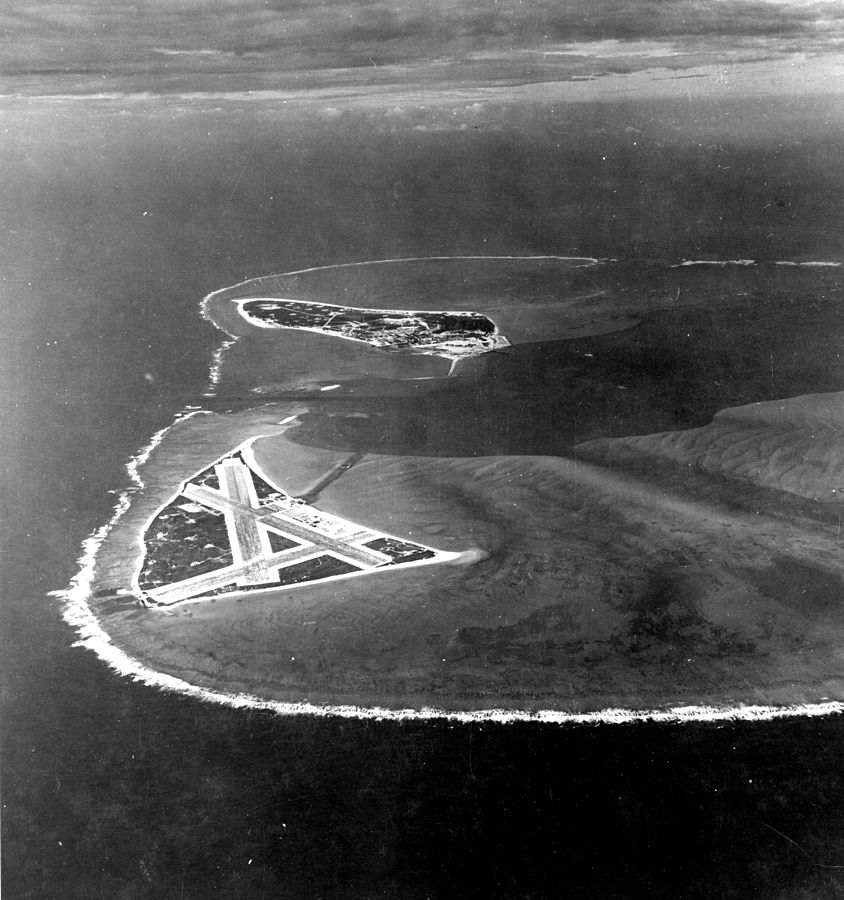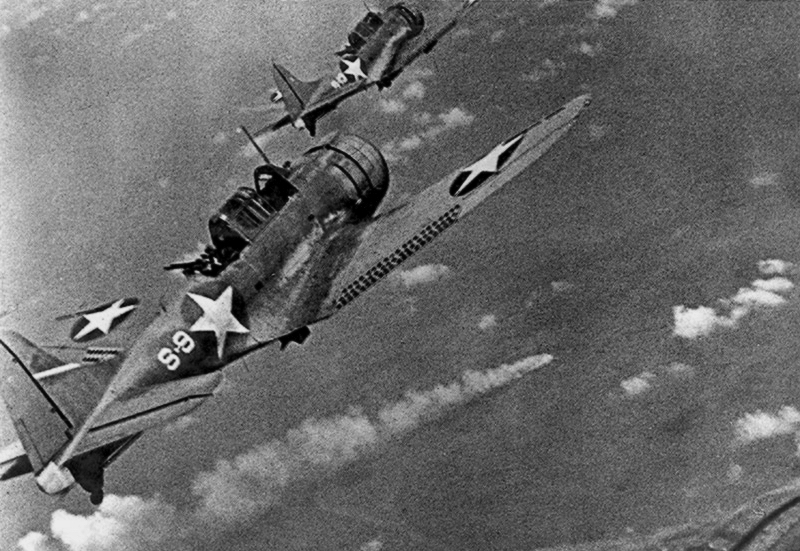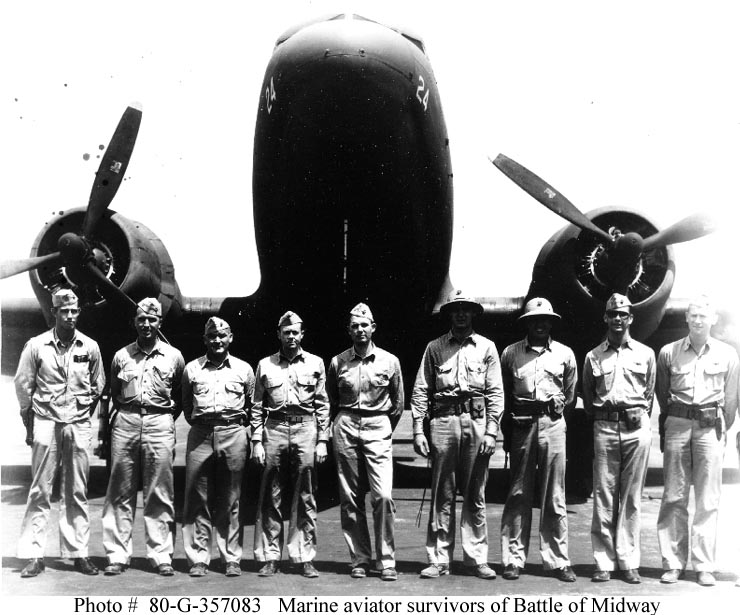Michael E. Haskew
During the weeks that followed the outbreak of war, the garrison on Midway was steadily augmented. On December 17, the arrival of 17 Vought SB2U Vindicator dive-bombers of Marine Scout Bombing Squadron 231 (VMSB 231) arrived, completing the long flight from Hawaii. Within a couple of days more reinforcements were delivered. The 5 in seacoast guns of Batteries A and C, 4th Defense Battalion came ashore. Hours later, 14 obsolete F2A-3 Brewster Buffalo aircraft, the vanguard of Marine Fighter Squadron 221 (VMF 221), landed at Midway.

Midway Atoll, several months before the battle. Eastern Island (with the airfield) is in the foreground, and the larger Sand Island is in the background to the west. By USN – Official U.S. Navy photo 80-G-451086 from the U.S. Navy Naval History and Heritage Command. Image is in the public domain via Wikimedia.com
By the first week of June 1942, Midway was defended by 3652 men of the 6th Marine Defense Battalion supplemented by elements of the 3rd Marine Defense Battalion and the two companies of the 2nd Marine Raider Battalion. Its air group, under Lieutenant Colonel Kimes, included the six operational Wildcat and 21 Buffalo fighters of VMF 221 commanded by Major Floyd B. “Red” Parks, and the 18 Dauntlesses and 21 Vindicators of VMSB-241 (the squadron had split and been renamed) under Major Lofton R. Henderson.
Air Attacks on VMF 221
Until the moment that the enemy was sighted on June 4, 1942, the Americans defending Midway had been in the dark as to the grand design that was unfolding around them. The first Japanese attack included 108 bombers and dive-bombers, intent on destroying the runway at Midway and making the
airfield inoperative.
At 5.20 a.m., Midway reconnaissance sighted a Japanese aircraft carrier, and followed that with a report that enemy aircraft were approaching the atoll. Within minutes, every aircraft on Midway was sent aloft. Flying at 14,000ft (427m) roughly 30 miles (48km) distant from Midway, the pilots of VMF 221
spotted a large number of Japanese Vals flying in V-formations with accompanying Zeros. Major Parks’ fighters were divided into two groups. Flying a Buffalo, Parks led the first group of eight F2As and five Wildcats. The second group, under the command of Captain Kirk Armistead, consisted of 12 Buffalo fighters and a single Wildcat. Parks led his fighters directly into the Japanese formations, while Armistead’s group acted as a reserve.
Later, at 6.30 a.m., the Japanese force reached Midway. Bombs destroyed the seaplane hangar, and the fuel dump 1500ft (457m) was engulfed in flames. Major William Benson, in charge of the 6th Defense Battalion’s Eastern Island command post, was killed when a direct hit demolished the position.
In total, 24 Americans were killed and 18 wounded.
The Japanese suffer heavy casualties
However, the Japanese paid a substantial price, as 11 attacking planes were either shot down or failed to return to their carriers and more than 40 were damaged, some of them beyond repair. The Marine anti-aircraft fire had been so accurate that it disrupted the Japanese attempts to crater the all-important airstrip. Only a couple of small holes had been made, and it remained functional.

When the Japanese planes were gone, the Midway air controller sent a message: “Fighters land. Refuel by divisions, 5th Division first.” The only response was a crackle of dead air. The message went out several times, and finally a general recall was broadcast. With “All fighters land and reservice,” only 10 VMF 221 planes came in. Of these just two remained airworthy.
With their location known, Kimes threw every available Midway-based aircraft at Nagumo’s carriers. More than 50 planes without fighter escort mounted no fewer than five separate attacks against Nagumo’s warships during a roughly 90-minute period from 7.05 a.m. to just after 8.30.
The US mounts a counter attack
Captain James F. Collins led the four Army Air Corps Marauders, which mounted attacks on the Japanese carriers almost simultaneously with the six Navy TBF Avengers under Lieutenant Langdon K. Fieberling. No hits were scored. These were followed less than an hour later by the 16 Marine Corps Dauntless dive-bombers of VMSB-241. At 7.55 a.m., Major Henderson called out, “Attack two enemy CV on port bow!” Most of the Dauntless pilots were inexperienced, and Henderson elected a glide-bombing run rather than a steep dive-bombing attack. Quickly, the Zeros pounced on the squadron commander, whose plane was seen spiraling into the sea with one wing afire.
At approximately 8.20 a.m., 11 lumbering VMSB-241 Vindicators led by Major Benjamin W. Norris found the Japanese carriers. Norris knew that the nimble Zero fighters were likely to slaughter his obsolete dive-bombers and observed that the Japanese escort ships were putting up a veritable curtain of anti-aircraft fire. He elected to attack the closest targets, the enemy battleships, but without making any hits.

The aftermath
At least 19 American planes were shot down during the raids by Midway’s planes, with only three Zeros downed. Although preliminary analysis might indicate that the gallant attacks were in vain, this is not the case. The Marine, Army, and Navy bomber pilots had stretched the Japanese combat air patrol resources to the limits of their pilots’ endurance. More Zeros had to be launched, and those aloft needed to land to be rearmed and refueled.
Michael E. Haskew is the editor of WWII History Magazine and the former editor of World War II Magazine . He is the author of a number of books, including THE MARINES IN WORLD WAR II. The Sniper at War and Order of Battle. Haskew is also the editor of The World War II Desk Reference with the Eisenhower Center for American Studies. He lives in Hixson, Tennessee.
